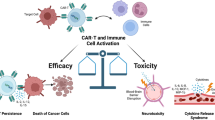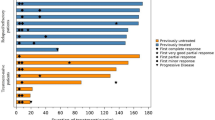Abstract
Indolent non-follicular non-Hodgkin lymphomas (INFL) are a heterogenous subset whose treatment has been poorly investigated. In this context we have evaluated the efficacy and safety of combined fludarabine and cyclophosphamide (FC) upfront therapy. Sixty-three patients with advanced INFL were enrolled in the study. Therapy consisted in FC combination (25 and 250 mg/m2, i.v., respectively, for three consecutive days) every 28 days for six courses. After histological review, 61 patients (36 men, median age 64 years, range 40–70 years) were evaluated (22 small lymphocytic, 11 lymphoplasmacytic, 25 marginal zone and 3 CD5-negative non-Hodgkin lymphomas not otherwise specified). Further two patients were excluded for lack of essential data; six patients were withdrawn before the third cycle because of WHO grade III and IV toxicity. At the final evaluation, the overall response rate was 83% with 40.7% of complete remission. Intention-to-treat analysis showed that at the median follow-up of 36 months, overall survival, progression-free survival and failure-free survival were respectively 78%, 60% and 46%; remission duration among the 49 patients achieving complete remission/partial remission at the end of treatment was 65% (44–78) without significant differences between the main histotypes. The most frequent grade III and IV toxic events were haematological (neutropaenia 34%, anaemia 18% and thrombocytopaenia 11%) and infectious (10%). FC is effective for advanced untreated INFL. Early deaths and haematological toxicity suggest careful patient selection and monitoring.



Similar content being viewed by others
References
Jaffe ES, Harris NL, Stein H, Vardiman JW (2001) World Health Organization classification of tumours of hematopoietic and lymphoid tissues, 3rd edn. IARC, Lyon
Ben-Ezra J, Burke JS, Swartz WG, Brownell MD, Brynes RK, Hill LR et al (1989) Small lymphocytic lymphoma: a clinicopathologic analysis of 268 cases. Blood 73:579–587
Coiffier B, Thieblemont C, Felman P, Salles G, Berger F (1999) Indolent non follicular lymphomas: characteristics, treatment, and outcome. Semin Hematol 36:198–208
Landgren O, Tilly H (2008) Epidemiology, pathology and treatment of non-follicular indolent lymphomas. Leuk Lymphoma 49(Suppl 1):35–42
Pangalis GA, Angelopoulou MK, Vassilakopoulos TP, Siakantaris MP, Kittas C (1999) B-chronic lymphocytic leukemia, small lymphocytic lymphoma, and lymphoplasmacytic lymphoma, including Waldenstrom’s macroglobulinemia: a clinical, morphologic, and biologic spectrum of similar disorders. Semin Hematol 36:104–114
Papamichael D, Norton AJ, Foran JM, Mulatero C, Mathews J, Amess JA et al (1999) Immunocytoma: a retrospective analysis from St Bartholomew’s Hospital—1972 to 1996. J Clin Oncol 17:2847–2853
Seng JE, Peterson BA (1997) Indolent B-cell non-Hodgkin’s lymphomas. Oncology (Williston Park) 11:1883–1894
Treon SP (2009) How I treat Waldenström macroglobulinemia. Blood 17:2375–2385
Neparidze N, Dhodapkar MV (2009) Waldenstrom’s macroglobulinemia: recent advances in biology and therapy. Clin Adv Hematol Oncol 7:677–681, 687–690
Baldini L, Brugiatelli M, Luminari S, Lombardo M, Merli F, Sacchi S et al (2003) Treatment of indolent B-cell nonfollicular lymphomas: final results of the LL01 randomized trial of the Gruppo Italiano per lo Studio dei Linfomi. J Clin Oncol 21:1459–1465
Rai KR, Peterson BL, Appelbaum FR, Kolitz J, Elias L, Shepherd L et al (2000) Fludarabine compared with chlorambucil as primary therapy for chronic lymphocytic leukemia. N Engl J Med 343:1750–1757
Johnson S, Smith AG, Loffler H, Osby E, Juliusson G, Emmerich B et al (1996) Multicentre prospective randomised trial of fludarabine versus cyclophosphamide, doxorubicin, and prednisone (CAP) for treatment of advanced-stage chronic lymphocytic leukaemia. The French Cooperative Group on CLL. Lancet 347:1432–1438
Leporrier M, Chevret S, Cazin B, Boudjerra N, Feugier P, Desablens B et al (2001) Randomized comparison of fludarabine, CAP, and ChOP in 938 previously untreated stage B and C chronic lymphocytic leukemia patients. Blood 98:2319–2325
Bellosillo B, Villamor N, Colomer D, Pons G, Montserrat E, Gil J (1999) In vitro evaluation of fludarabine in combination with cyclophosphamide and/or mitoxantrone in B-cell chronic lymphocytic leukemia. Blood 94:2836–2843
O’Brien SM, Kantarjian HM, Cortes J, Beran M, Koller CA, Giles FJ et al (2001) Results of the fludarabine and cyclophosphamide combination regimen in chronic lymphocytic leukemia. J Clin Oncol 19:1414–1420
Cheson BD, Horning SJ, Coiffier B, Shipp MA, Fisher RI, Connors JM et al (1999) Report of an international workshop to standardize response criteria for non-Hodgkin’s lymphomas. NCI Sponsored International Working Group. J Clin Oncol 17:1244–1253
Kaplan EI, Meier P (1958) Non parametric evaluation from incomplete observations. J Am Stat Assoc 53:457–481
Oken MM, Creech RH, Tormey DC, Horton J, Davis TE, McFadden ET et al (1982) Toxicity and response criteria of the Eastern Cooperative Oncology Group. Am J Clin Oncol 5:649–655
Hallek M, Schmitt B, Wilhelm M, Busch R, Krober A, Fostitsch HP et al (2001) Fludarabine plus cyclophosphamide is an efficient treatment for advanced chronic lymphocytic leukaemia (CLL): results of a phase II study of the German CLL Study Group. Br J Haematol 114:342–348
Schiavone EM, De SM, Palmieri S, Annunziata M, Pocali B, Copia C et al (2003) Fludarabine plus cyclophosphamide for the treatment of advanced chronic lymphocytic leukemia. Eur J Haematol 71:23–28
Catovsky D, Richards S, Matutes E, Oscier D, Dyer MJ, Bezares RF et al (2007) Assessment of fludarabine plus cyclophosphamide for patients with chronic lymphocytic leukaemia (the LRF CLL4 Trial): a randomised controlled trial. Lancet 370:230–239
Eichhorst BF, Busch R, Hopfinger G, Pasold R, Hensel M, Steinbrecher C et al (2006) Fludarabine plus cyclophosphamide versus fludarabine alone in first-line therapy of younger patients with chronic lymphocytic leukemia. Blood 107:885–891
Flinn IW, Neuberg DS, Grever MR, Dewald GW, Bennett JM, Paietta EM et al (2007) Phase III trial of fludarabine plus cyclophosphamide compared with fludarabine for patients with previously untreated chronic lymphocytic leukemia: US Intergroup Trial E2997. J Clin Oncol 25:793–798
Tam CS, Wolf MM, Januszewicz EH, Prince HM, Westerman D, Seymour JF (2004) Fludarabine and cyclophosphamide using an attenuated dose schedule is a highly effective regimen for patients with indolent lymphoid malignancies. Cancer 100:2181–2189
Flinn IW, Byrd JC, Morrison C, Jamison J, Diehl LF, Murphy T et al (2000) Fludarabine and cyclophosphamide with filgrastim support in patients with previously untreated indolent lymphoid malignancies. Blood 96:71–75
Hochster HS, Oken MM, Winter JN, Gordon LI, Raphael BG, Bennett JM et al (2000) Phase I study of fludarabine plus cyclophosphamide in patients with previously untreated low-grade lymphoma: results and long-term follow-up—a report from the Eastern Cooperative Oncology Group. J Clin Oncol 18:987–994
Dimopoulos MA, Hamilos G, Efstathiou E, Siapkaras I, Matsouka C, Gika D et al (2003) Treatment of Waldenstrom’s macroglobulinemia with the combination of fludarabine and cyclophosphamide. Leuk Lymphoma 44:993–996
Tam CS, Seymour JF, Prince HM, Kenealy M, Wolf M, Januszewicz EH et al (2006) Treatment-related myelodysplasia following fludarabine combination chemotherapy. Haematologica 91:1546–1550
Armitage JO, Carbone PP, Connors JM, Levine A, Bennett JM, Kroll S (2003) Treatment-related myelodysplasia and acute leukemia in non-Hodgkin’s lymphoma patients. J Clin Oncol 21:897–906
Yamauchi T, Nowak BJ, Keating MJ, Plunkett W (2001) DNA repair initiated in chronic lymphocytic leukemia lymphocytes by 4-hydroperoxycyclophosphamide is inhibited by fludarabine and clofarabine. Clin Cancer Res 7:3580–3589
Tam CS, O’Brien S, Wierda W, Kantarjian H, Wen S, Do KA et al (2008) Long-term results of the fludarabine, cyclophosphamide, and rituximab regimen as initial therapy of chronic lymphocytic leukemia. Blood 112:975–980
Tam CS, Wolf M, Prince HM, Januszewicz EH, Westerman D, Lin KI et al (2006) Fludarabine, cyclophosphamide, and rituximab for the treatment of patients with chronic lymphocytic leukemia or indolent non-Hodgkin lymphoma. Cancer 106:2412–2420
Hallek M, Fingerle-Rowson G, Fink AM, Busch R, Mayer J, Hensel M et al (2009) First-line treatment with fludarabine (F), cyclophosphamide (C), and rituximab (R) (FCR) improves overall survival (OS) in previously untreated patients (pts) with advanced chronic lymphocytic leukemia (CLL): results of a randomized phase III trial on behalf of an International Group of Investigators and the German CLL Study Group. Blood 114:535 (ASH Annual Meeting Abstracts)
Robak T, Dmoszynska A, Solal-Céligny P, Warzocha K, Loscertales J, Catalano J et al (2010) Rituximab plus fludarabine and cyclophosphamide prolongs progression-free survival compared with fludarabine and cyclophosphamide alone in previously treated chronic lymphocytic leukemia. J Clin Oncol 28:1756–1765
Baldini L, Pulsoni A, Rossi G, Vitolo U, Morra E, Olivero B, Cavalieri E, Merli F, Rigacci L, Nobile F, Ferrario A, Orsucci L, Brugiatelli M, Musto P, Lambertenghi Deliliers G, Gamba E (2009) Front-line chemo-immunotherapy rituximab-FC + rituximab maintenance in patients with untreated advanced stage non follicular lymphoma (INFL): update of a prospective study of the Intergruppo Italiano Linfomi and Roche (ML18324). Blood 114:2686 (ASH Annual Meeting Abstracts)
Acknowledgements
We would like to thank Dr. A. Sirotti (Department of Oncology and Hematology, University of Modena and Reggio Emilia) for her support in data collection and management. This study was supported by a grant (Ricerca Corrente) from the Italian Ministry of Health to Ospedale Maggiore IRCCS, Milan, Italy, and a grant from Associazione Angela Serra, Modena, Italy.
The authors have declared no conflicts of interest.
Author information
Authors and Affiliations
Consortia
Corresponding author
Additional information
Other participating institutions include the following: Lombardo M., Oncologia Pescara; Bagnuolo A., Oncologia, Correggio; Nunzi M., Medicina e Oncologia, Terni; Mastrullo L., Ematologia, Ospedale S Gennaro, Napoli; Fregoni V., Oncologia, Istituto scientifico fondazione Maugeri, Pavia; Centurioni R,. Medicina e Ematologia, Civitanova Marche; Giglio G., Az. Osp Cardarelli, Campobasso; Ginaldi L., Università di l’Aquila-Teramo, Teramo, Italy; Riezzo A., Divisione di Ematologia, Trani; Fragasso A., Oncoematologia, Matera; Caparrotti G., Ematologia, Caserta; Partesotti G., Oncologia, Sassuolo; Vallisa D., Ematologia, Piacenza; Girmenia GP, Medicina e Ematologia, Abbiategrasso; Polimeno G., Medicina e Ematologia, Acquaviva delle Fonti; Musolino C., Ematologia, Policlinico, Messina.
A complete list of the GISL centres referring patients for the study is given in a footnote at the end of this article.
Rights and permissions
About this article
Cite this article
Ferrario, A., Merli, F., Luminari, S. et al. Phase II fludarabine and cyclophosphamide for the treatment of indolent B cell non-follicular lymphomas: final results of the LL02 trialof the Gruppo Italiano per lo Studio dei Linfomi (GISL). Ann Hematol 90, 323–330 (2011). https://doi.org/10.1007/s00277-010-1067-1
Received:
Accepted:
Published:
Issue Date:
DOI: https://doi.org/10.1007/s00277-010-1067-1




